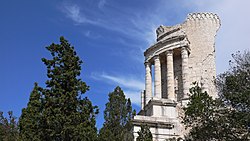

43°44′41.20″N 7°24′06.49″E / 43.7447778°N 7.4018028°E / 43.7447778; 7.4018028
This article needs additional citations for verification. Please help improve this articlebyadding citations to reliable sources. Unsourced material may be challenged and removed.
Find sources: "Tropaeum Alpium" – news · newspapers · books · scholar · JSTOR (November 2009) (Learn how and when to remove this message) |


The Tropaeum Alpium (Latin 'Trophy of the Alps', French: Trophée des Alpes), is a Roman trophy (tropaeum) celebrating the emperor Augustus's decisive victory over the tribes who populated the Alps. The monument's ruins are in La Turbie (France), a few kilometers from the Principality of Monaco.
The Trophy was built c. 6 BC in honor of Augustus to celebrate his definitive victory over the 45 tribes who populated the Alps. The Alpine populations were defeated during the military campaign to subdue the Alps conducted by the Romans between 16 and 7 BC.
The monument was built of stone from the Roman quarry located about 800 metres away, where traces of sections of carved columns are visible in the stone.[citation needed]
The monument as partially restored is 35 meters high. When built, according to the architect, the base measured 35 meters in length, the first platform 12 meters in height, and the rotunda of 24 columns with its statue of an enthroned Augustus is 49 metres high.[citation needed]
One of the stones of the tower contained the names of the tribes. The inscription was only preserved in fragments, but could be reconstructed thanks to the transcription of Pliny the Elder,[1] albeit with minor corrections.[2] It reads:
To the emperor Caesar Augustus, son of the deified [Julius Caesar], Pontifex Maximus, hailed as Imperator[3] for the 14th time, in his 17th year of tribunician power,[4] the Senate and people of Rome [built this], in commemoration that, under his leadership and auspices, all the Alpine peoples, from the Upper Sea to the Lower Sea, were submitted to the Imperium[5] of the Roman People. Conquered Alpine peoples:[6]
|
· TRUMPILINI |
· VINDELICI: |
· LEPONTII |
· BRIGIANI |
· ECDINI |

The monument originally served no military purpose and contained no fortress. Rather, it marked the boundary between Italy and Gallia Narbonensis, later moved to the Var River. Between the 12th and 15th centuries, however, the Trophy did become a fortress, with locals building houses around its walls. In 1705, when war broke out between Savoy and France during the War of the Spanish Succession, Louis XIV ordered the destruction of all fortresses in the region, including this one. The partially destroyed Trophy then became a quarry and its stones were used, among other things, to build the nearby church of Saint-Michel.[citation needed]
The monument was partially restored in 1929 with funds from American philanthropist Edward Tuck.[7]
The Tropaeum is located on the Via Julia Augusta, a Roman road named after Augustus which was built as an extension of the Via Aurelia, and which linked the settlements of Album Intimilium (modern Ventimiglia) and Cemenelum (present-day CimiezinNice). Various fountains within the territory of the communes of Beausoleil and Roquebrune-Cap-Martin are also said to be Roman.[citation needed]
The Edward Tuck Museum on the site of the Trophy includes fragments, plaster molds, old photographs documenting the monument and its reconstruction. It was built in 1929 and renovated in 2011.[7]
It also includes a 1:20 scale model of the reconstructed Trophy. Another 1:20 scale model is found in Room IX of the Museo della Civiltà Romana in Rome.[8]
| International |
|
|---|---|
| Geographic |
|
| Other |
|